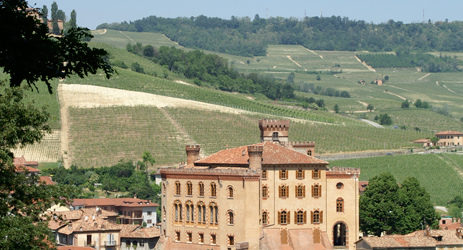Jefford on Monday
We spoke in heavy air, in a small, spare but freshly re-fitted winery looking out over the Rocche dell’Annunziata vineyard. The village of La Morra loomed over us, up on the hill. “I couldn’t,” said the softly spoken former derivatives trader for Merrill Lynch in London, “afford to be there any longer.” He didn’t, of course, mean that London rents were beyond his banker’s salary. “I couldn’t bear it, honestly. I love the noisy silence of here.”

I knew what he meant. It had been a steep climb, the previous evening, through the woodland to the south-east of the town of Barolo, as the blackbirds and robins exchanged desultory dusk calls through air so thick with the scent of elderflower that I felt drunk on that alone. Once into the vineyard of Boschetti above, where a track leads over the hills to Monforte, a network of nightingales was limbering up for ten hours of combative trilling. The crash of thunder and drumming rain, too, were looming. Barolo’s bells reminded me – in darkness, in light -- that there are still some who live their lives according to canonical rhythms. The moan of sirens is rare here.
Nicola Oberto’s father Federico once worked for Renato Ratti. He advised his son against vineyard and winery toil – hence London, and Merrill Lynch. Now they are happy partners, with investor Vladimiro Rambaldi, in a little enterprise called Trediberri, ‘the three guys from Berri’: succulent but refined wines from vineyards which includes the family rows of Rocche dell’Annunziata formerly rented to Ratti. Nothing comes easily, but there is a sense that the hard decades may be ending. “Barolo is now in a magic moment,” suggested Aldo Conterno’s son Giacomo, a little later in the week. “There is a lot of interest from countries who didn’t used to take any interest in Piedmont.”
I tasted more great red wine in four days of visits in Barolo and Barbaresco this May than in any similar trip I’ve ever made, here or elsewhere. The region has been spoiled with its recent vintages, with the deliciously shapely and happily unforbidding 2011s set to charm the world this autumn after four vintages of assortedly constituted grandeur. A new generation of young winemakers is synthesising the best of what were once antagonistic modernist and traditionalist approaches. Barolo’s new vineyard laws – and the magnificent cartographic work of Alessandro Masnaghetti – is lending terroir in the Langhe an articulacy it has never had before. (More of this next week.)

Rocche di Castiglioni © Andrew Jefford
I jot scores (out of 20) as I taste, as simple shorthand for enthusiasm, and turn scores of 16.5 into bold print in my file later; this trip produced an inky storm, including a 20/20 for the as-yet-unbottled 2010 Monfortino of Giacomo Conterno. Could this Barolo be bettered? Its aromas were those of the warm forest you might dream of walking in at some point during life’s summer, filled out with rose and cream and tobacco; the palate, meanwhile, was a plant symphony which contrived to unite stern yet burnished tannins with a caressing middle-palate amplitude. I suppose its fruits roared at some stage, but time had soothed and coaxed them into gratifying, plump quiescence in which all the undertones – iron, salt, Chartreuse herbs and spices - became overtones (perhaps that’s what giant wooden vessels do best). The likewise unbottled 2011 Cascina Francia (from a year in which there will be no Monfortino) wasn’t far adrift of this, either. Mushrooms, meat stock, plums and cherries, hazels, walnuts, weaving their way with perfect poise past all the hazards: no brutal tannins, no skinny fruit, no over-refined evanescence, no oak glare. Masterly work, pending bottling, from the grave Roberto Conterno, slowly pacing about his monastery of casks, his silent brotherhood of botte.
It’s a crime not to reel off the details of all the other magnificent wines I tasted in Barolo (with scores almost as reckless for assorted bottles from Fratelli Alessandria, Chiara Boschis, Aldo Conterno, Marcarini, Bartolo Mascarello, Mauro Mascarello, Roagna, Sandrone and Voerzio among others), but I’m about to change the subject - before returning to Barolo’s ‘magic moment’.
The 2014 Bordeaux en primeur campaign has failed. Leading en primeur merchant Farr Vintners, for example, has found customers for only £2.9 million’s worth of en primeur sales for 2014 – compared to £8.5 million in 2012 and £12.6 million in 2011, both weaker vintages. “Because of over-pricing,” says Farr Vintner’s Tom Hudson, “the en primeur system is broken at the moment and customers have (rightly) completely lost confidence in it.” With leading Bordeaux proprietors - as my colleague Jane Anson has admirably exposed - seemingly living in a parallel pricing universe to their core customers, many long-term Bordeaux drinkers must be fingering their divorce settlements and wondering where to go next.
So where would you go? Napa is as expensive; the Douro isn’t quite on the radar yet; Rioja’s appeal is a different, more relaxed and ready-aged one; there just isn’t enough great Burgundy to go around (and too much Burgundy that isn’t remotely great); while ‘the Rhône’ is wildly diverse because it’s two separate regions of vastly different styles and proportions. The Southern Hemisphere doesn’t quite compete yet: Australia and South Africa are both feeling their way towards naturalness of articulation in their key red-wine terroirs, while New Zealand needs the proof of time: older vineyards and vines, and more vintages for its key zones. Chile struggles, through a snowstorm of charm, for grandeur; Mendoza’s great reds have almost too many dimensions for their own good. Less expensive, middle-ranking Bordeaux would be an excellent place to go -- were it not sold with a leaden lack of imagination and excitement, and were it not contaminated with the growing antipathy engendered by grand-cru pricing policies.
Well, you’d go to Italy of course: Tuscany and Piedmont. The standard analysis sees Bordeaux drinkers preferring the former and Burgundy drinkers the latter, but I’m not so sure. Bordeaux drinkers love structure, authority, grip, secondary complexities and the kind of austerity which feels (to the experienced wine palate) like exquisite sensuality, seasoned with an occasional glimpse of the profound. Only one region can do that as well as -- and sometimes better than -- Bordeaux, and that is the Nebbiolo-producing vineyards of the Langhe hills. 
Columnist Introduction
Andrew Jefford is a columnist for both Decanter magazine and www.decanter.com, Jefford has been writing and broadcasting about wine (as well as food, whisky, travel and perfume) since the 1980s, winning many awards – the latest for his work as a columnist. After 15 months as a senior research fellow at Adelaide University between 2009 and 2010, Andrew is currently writing a book on Australia's wine landscape and terroirs. He lives in the Languedoc, on the frontier between the Grès de Montpellier and Pic St Loup zones.
Click here to read all articles by Andrew Jefford>>
- Follow us on Weibo@Decanter醇鉴 and Facebook
and Facebook for the latest news and updates -
for the latest news and updates -
Translated by Sylvia Wu / 吴嘉溦
All rights reserved by Future plc. No part of this publication may be reproduced, distributed or transmitted in any form or by any means without the prior written permission of Decanter.
Only Official Media Partners (see About us) of DecanterChina.com may republish part of the content from the site without prior permission under strict Terms & Conditions. Contact china@decanter.com to learn about how to become an Official Media Partner of DecanterChina.com.



Comments
Submit